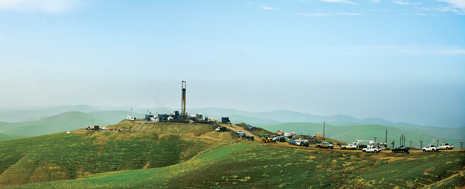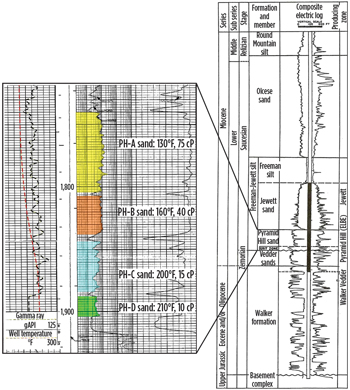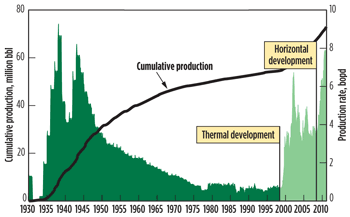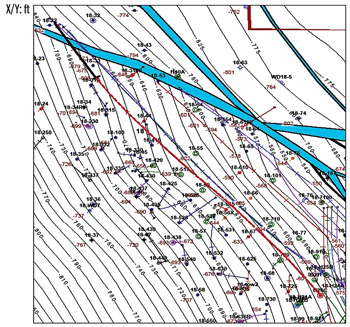
A California operator found that its thermal production program using vertical wells improved heavy oil mobility in a shallower, low-permeability zone, enabling improved productivity using horizontal wells.
DONALD R. MACPHERSON and RON PALMER, Macpherson Energy Corporation
In the past two years, Macpherson Energy, through its operating company Macpherson Oil Company, has brought 56 wells into production using horizontal drilling in California’s Round Mountain oil field, northeast of Bakersfield, and has expanded production from the field nearly threefold. This increase has come about while Kern County, where the field is located, has seen its overall oil production decrease from about 166 million bbl (455,000 bpd) in 2007 to 162 million bbl (443,000 bpd) in 2008 to 155 million bbl (425,000 bpd) in 2009, according to the state Department of Conservation.
Improved extraction at Round Mountain has benefited from decades of experience building an in-depth knowledge of the field’s geology and development history. In particular, the warming of the target zone as a result of steamflooding in a lower zone during the previous decade has improved productivity from the current horizontal wells. Furthermore, in-the-field decision making has maximized the opportunities made possible by improved drilling technology.
GEOLOGY AND PRODUCTION HISTORY
The region’s oil reservoirs, which range in age from fractured Mesozoic basement rocks to Holocene non-marine rocks, are mainly Oligocene to Miocene sandstones and non-marine sandstones and conglomerates, mostly of Pliocene to Pleistocene age. All known oil accumulations in the area are derived from source rocks of Middle to Late Miocene age, according to the US Geological Survey.
The Round Mountain oil field has four overlying zones:
1. Olcese (surface to 1,100 ft)
2. Freeman/Jewett (1,100–1,640 ft)
3. Pyramid Hill (about 1,643–1,792 ft)
4. Vedder (about 1,800–1,890 ft).
Of these, only the Olcese zone is not currently productive. The Pyramid Hill zone contains four sub-zones or lobes: PH-A (1,643–1,705 ft), PH-B (1,705–1,731 ft), PH-C (1,731–1,773 ft) and PH-D (1,773–1,792 ft), Fig. 1. Oil from the Pyramid Hill zone has a gravity of 19° API; oil from the Vedder zone has 16°API gravity.
Round Mountain began producing oil in 1927. The field was developed quickly, with production peaking in 1938 at more than 10,000 bpd, and declined steadily after World War II. By the 1960s, output had fallen over 80% to less than 2,000 bpd.
Secondary and tertiary recovery methods were initiated in the field during the 1990s and 2000s; more than 80 million bbl of steam was injected into the Vedder zone over 12 years, beginning in 1998. Wells that had produced 7,000 bpd of water and 7–10 bpd of oil before steam injection improved to 200 bopd and 2,000 bwpd with steam injection. In all, the process improved oil production twentyfold, Fig. 2.
 |
|
Fig. 1. Formations of the Round Mountain oil field with Pyramid Hill subzones showing depth, temperature and viscosity.
|
|
Round Mountain is more dynamic than most oil fields because of an active aquifer in the area. This complicates oil extraction from the Vedder zone, as the large volume of subsurface water can cool the steam, the oil and the reservoir rock. Yet, while subsurface water tended to cool the Vedder zone, engineers for the operator determined that the Pyramid Hill zone was getting warmer because heat from the steam injected into the Vedder zone was migrating upward into the Pyramid Hill zone by conduction, creating a “hot plate” effect. In 2007, temperature surveys in vertical wells that reached into the Vedder zone showed that the Pyramid Hill zone was warmer than the natural reservoir temperatures in areas directly above steam injection areas. The heat from the steam reduced the viscosity of the low-gravity oil by 80–90% in the Pyramid Hill zone. There were about a dozen injection areas in the Vedder zone, which gave the operator team an idea of where to start drilling the horizontal wells.
FIRST PYRAMID HILLS WELLS
Between 2004 and 2008, the vertical wells in the Pyramid Hill zone produced 15–20 bpd of oil. As oil prices surpassed $50/bbl, and with the increasing availability of rotary steerable technology for horizontal drilling, the operator’s engineering committee recommended three horizontal wells in the Pyramid Hill zone with an expectation of 100-bopd production from each.
Drilling began on the first horizontal well (Section 17-H2) in December 2008 using a conventional rotary rig. The well was located in the heart of the Pyramid Hill producing area, directly above an existing steam chest in the Vedder zone. On the second day of drilling, the crew lost returns at 586 ft and subsequently drilled blind until 2,346 ft. Then the crew ran 8⅝-in. surface casing, but got stuck at 476 ft. The casing was pulled out, after which the crew attempted an 11¾-in. bull-nose hole opener. This in turn got stuck at 583 ft and was recovered down to 494 ft. Attempts to retrieve the stuck drill pipe for two days were unsuccessful, and the well was abandoned.
The second well (Section 20-H3) was drilled near the first well, targeting the same reservoir, with two key technical changes. First, the drillers drilled the surface hole and cemented in place a 10¾-in. casing at 1,075 ft to isolate the lost-circulation areas in the shallow Olcese zone. Second, after losing circulation, the engineers insisted on “time drilling”—no faster than 60 ft/hr, in contrast to the 120–150 ft/hr typical for drilling in Kern County oil fields. This lower ROP reduced the pressure necessary for pumping the drilling fluid, which in turn reduced the probability of fracturing the formation and losing circulation. Initially, the drilling contractors were reluctant to drill slowly because other owners incentivized speed and penalized slowdowns; requiring time drilling was a paradigm change.
The well took 14 days to drill and complete, with a total length of 4,701 ft MD (1,728 ft TVD) and a lateral reach of 2,417 ft. It commenced production on Jan. 2, 2009, and stabilized three days later at an oil rate of 289 bpd, nearly three times the engineers’ expectation.
 |
|
Fig. 2. Round Mountain field production history.
|
|
Project engineers waited a month to assess the lessons learned from the first two wells, then began the third horizontal well (Section 18-H1) in February 2009. This time they utilized time drilling from spud to TD, but they did not set surface casing. Drillers had good circulation to 1,650 ft and were able to restore circulation at that depth by pumping lost-circulation material. The well came online at 250 bpd when it was completed with a length of 4,546 ft MD (1,897 ft TVD) and a lateral extent of 2,174 ft.
TECHNOLOGY AND APPROACH
With the success of the second and third wells, the operator decided to switch its development program entirely to horizontal wells in the Pyramid Hill zone, while continuing with vertical wells and steam injection in the Vedder zone below. This decision was based on the differences in porosity, permeability and oil gravity between the Pyramid Hill and other zones. At 150 mD, the Pyramid Hill zone had much lower permeability than most productive reservoirs in Kern County, which have permeabilities of 2 D or greater. The Vedder zone’s higher permeability (5–10 D) and large water volume made vertical drilling successful because drillers did not need to expose a higher surface area within the zone.
The engineers made a key change to the drilling program starting with the fourth horizontal well in the Pyramid Hill zone: They utilized a top-drive rig, which permitted more flexibility when problems arose during drilling by allowing drillers to back-ream out when they encountered high torque.
With increased confidence in the equipment and technology, the operator drilled 500 ft farther, increasing the MD-to-TVD ratio to 2.9:1 (from 2.7:1 for the Section 20-H3 well and 2.4:1 for the Section 18-H1 well). After testing this ratio successfully for five wells, the reach was extended an additional 200–300 ft for the next five wells. This practice of extending the lateral by 200 ft, testing for five wells, then extending again has continued. The most recent Pyramid Hill horizontal wells have been successfully completed at measured depths of 6,000–6,200 ft and TVDs of about 1,900 ft (for an MD-to-TVD ratio of 3.3:1), with up to 3,800 ft of horizontal reach. This extended-reach drilling approach has proven effective for substantially improving oil extraction from the Pyramid Hill zone.
The operator employs rotary steerable technology with a bed-detection tool for horizontal drilling. The MWD system, located less than 5 ft from the drill bit, uses electromagnetic telemetry to inform engineers at the surface of the bit’s precise vertical location, greatly improving their ability to keep the bore within the 15-ft-thick target zone. Automatic tracking allows the engineer to guide drilling to stay within the sweet spot. Adjustments can be as frequent as once a minute, though such frequency is rare. In addition to improved control and accuracy during drilling, this technology has also reduced overall drilling time by eliminating any need to pull out of the hole in order to survey the drill bit location, as had been the earlier practice.
 |
|
Fig. 3. Reservoir navigation base map showing the top of the Pyramid Hill-C sand. Horizontal wells (long red and blue lines) must be navigated around existing vertical wells.
|
|
Because the company had drilled scores of wells into the Vedder zone through the Pyramid Hill zone in the past, it had built a database of 3D models identifying the Pyramid Hill faults, the four different lobes of the zone, and the best places for new wells. However, even with each well location mapped, it is difficult to navigate new horizontal drilling through an oil field with more than 300 existing vertical wells, Fig. 3. Fortunately, the operator has not run into an existing well during horizontal drilling in the crowded field. Geosteering team members observe drilling progress on a surface monitor 24/7 and can direct the drill bit to move right 1°, move up 2° and so on as needed, not only to stay in the sweet spot but also to avoid existing vertical wells in the horizontal wellpath.
MAXIMIZING THERMAL OIL RECOVERY
Success of the dynamic Round Mountain thermal project depends on efficient production surveillance in both the Vedder and Pyramid Hill zones. The top-drive steamflood technique in the Vedder zone balances steam injection, water removal and the steam chest in order to locate the oil production wells most beneficially. Engineers develop a steam chest up-dip by injecting steam. At the same time, a water interception lift well is drilled to remove thousands of barrels of subsurface water per day to create a low-pressure sink down-dip (below the steam chest) in the Vedder oil reservoir. The steam then flows from the high-pressure zone to the low-pressure zone created by the lift well. As the steam expands, it heats the oil in the reservoir, lowering its viscosity and causing it to flow; locating the oil producing well at the right location allows the operator to capture this newly flowing oil. None of the subsurface water that is lifted in the top-drive steamflood process remains at the surface: 10% is heated and injected as steam, while 90% is reinjected into a deeper reservoir.
The process is complicated; rapid adjustments are often necessary to ensure that the production well is drilled at both the right location and the right time to most efficiently capture the largest possible volume of oil. In addition, it is not exceptional for a steam injection well to be abandoned and re-drilled in a different location. The operator’s small organization is helpful in this regard, allowing engineers to make rapid decisions in a dynamic field to operate the reservoir most efficiently.
GOING FORWARD
The Round Mountain oil field has produced about 70 million bbl since the first well was drilled there in 1927, including more than 15 million bbl through recent thermal recovery methods. Extractable oil is available in both the Vedder and Pyramid Hill zones. Future plans call for ongoing steam injection for vertical wells to fully develop the Vedder zone, as well as ongoing horizontal well drilling into the Pyramid Hill zone, with the Pyramid Hill production enhanced by the heat from Vedder zone steam.
The operator intends to continue its research and testing on expanding the reach of horizontal wells beyond the current 3.3:1 MD-to-TVD ratio in order to maximize oil production. About 100 more horizontal wells are planned over the next two years to complete the development of the Pyramid Hill zone in Round Mountain field. 
|
THE AUTHORS
|
|
DONALD R. MACPHERSON has 35 years of experience in the oil and gas industry, developing and redeveloping oil fields in California. Macpherson Oil Company was incorporated in 1981 with Macpherson as Vice President. He became president in 1986 and CEO of Macpherson Energy Corporation in 1999. He was twice president of the California Independent Petroleum Association and serves on the executive committee of the organization’s board of directors. |
|
| RON PALMER graduated from West Virginia University in 1987 with a BS degree in petroleum engineering. He began his career in 1988 with Mobil Oil, where he worked as a production engineer, reservoir engineer and production foreman until March 2005. He was an Operations Manager for Tartan Energy from March 2005 until July 2006, then joined Macpherson Oil Company in August 2006 as a Senior Production Engineer. |
|
|






